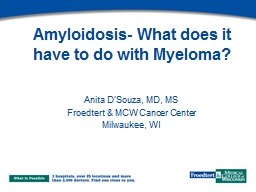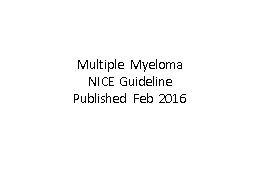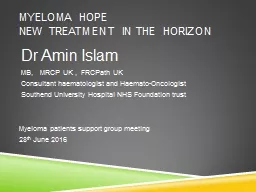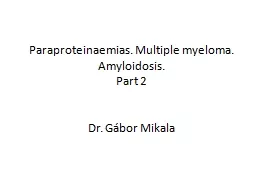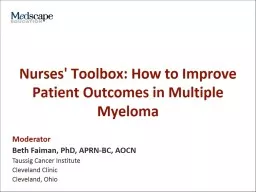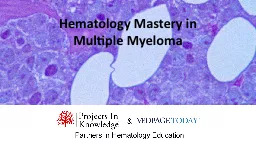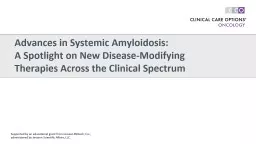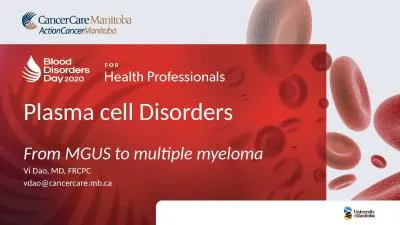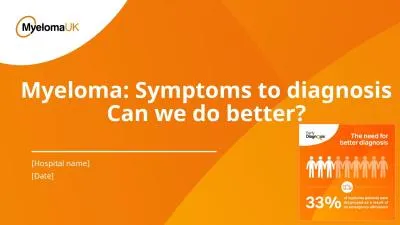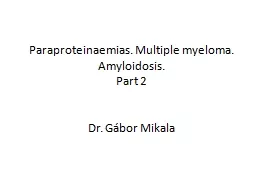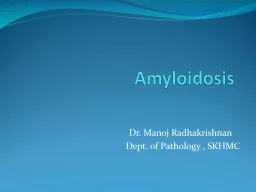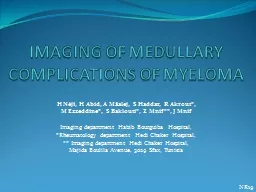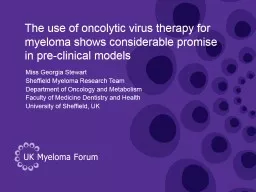PPT-Amyloidosis- What does it have to do with Myeloma?
Author : rose | Published Date : 2023-05-19
Anita DSouza MD MS Froedtert amp MCW Cancer Center Milwaukee WI Objectives Types of amyloidosis How does amyloidosis form Why does myeloma sometimes make amyloid
Presentation Embed Code
Download Presentation
Download Presentation The PPT/PDF document "Amyloidosis- What does it have to do wit..." is the property of its rightful owner. Permission is granted to download and print the materials on this website for personal, non-commercial use only, and to display it on your personal computer provided you do not modify the materials and that you retain all copyright notices contained in the materials. By downloading content from our website, you accept the terms of this agreement.
Amyloidosis- What does it have to do with Myeloma?: Transcript
Anita DSouza MD MS Froedtert amp MCW Cancer Center Milwaukee WI Objectives Types of amyloidosis How does amyloidosis form Why does myeloma sometimes make amyloid Treatment of amyloidosis. Dr Matthew Jenner. Consultant Haematologist. Southampton General Hospital . UK Myeloma Forum Autumn Day. 12 November 2014. Introduction. Why define high risk myeloma?. 3. Patient expectations. Outcomes vary widely between different patients. NICE Guideline. Published Feb 2016. Adults with myeloma (and plasma cell leukaemia). Excluded:. Monoclonal . gammopathy. of uncertain significance (MGUS). Amyloidosis. Solitary . plasmacytomas. Included:. new treatment in the horizon. Dr Amin . I. slam . MB, MRCP UK , FRCPath UK. Consultant haematologist and . H. aemato. -Oncologist. Southend University Hospital NHS Foundation trust. Myeloma patients support group meeting. . . Multiple. . myeloma. . . Amyloidosis. .. Part 2. Dr. Gábor . Mikala. Waldenström. . Macroglobulinemia. Uncontrolled proliferation of . lymphoplasmacytes. producing . IgM. Median age . 63 years. Program Goals. Defining Multiple Myeloma. Case 1. Diagnostic Criteria. Multiple Myeloma Requiring Therapy. Cytogenetic Risk Features. Case 1 (cont). Newly Diagnosed Multiple Myeloma. NCCN. ®. . Therapy for Transplant-Eligible Patients. Part I: Smoldering Multiple Myeloma . and . Induction Therapy for Patients with Newly Diagnosed Multiple Myeloma . Moderator: . Sagar. . Lonial. , MD. Panelists: . Jonathan Kaufman, MD and Ajay . Nooka. A Spotlight on New Disease-Modifying . Therapies Across the Clinical Spectrum. Supported by an educational grant from Janssen Biotech, Inc., administered by Janssen Scientific Affairs, LLC.. About These Slides. Vi Dao, MD, FRCPC. vdao@cancercare.mb.ca. Presenter Disclosure. Faculty: Vi Dao. Relationships with commercial interests: none. Mitigating Potential Bias. Not Applicable. Learning Objectives. Distinguish MGUS from multiple myeloma. Can we do better?. [Hospital name]. [Date]. What is myeloma?. Cancer of plasma cells. Leads to:. Bone infiltration. - fractures (especially vertebral wedge fractures), hypercalcaemia. - pain. . myeloma. . . Amyloidosis. .. Part 2. Dr. Gábor . Mikala. Waldenström. . Macroglobulinemia. Uncontrolled proliferation of . lymphoplasmacytes. producing . IgM. Median age . 63 years. Presents with weakness, fatigue, . . . Manoj. . Radhakrishnan. Dept. of Pathology , SKHMC. nature of . amyloid. amyloid. is a . protienaceous. substance deposited between cells in various tissues and organs in a variety of clinical settings. H . Nèji. , H . Abid. , A . Mâalej. , S . Haddar. , R . Akrout. *, . M . Ezzeddine. *, S . Baklouti. *, . Z . Mnif. **, J . Mnif. Imaging department . Habib. . Bourguiba. Hospital, . *Rheumatology department . Miss Georgia Stewart . Sheffield Myeloma Research Team. Department of Oncology and Metabolism. Faculty of Medicine Dentistry and Health . University of Sheffield, UK. Most Viruses have a preferential tropism for tumour cells. A Guide to Authored by Teresa Coelho, Bo - Goran Ericzon, Rodney Falk, Donna Grogan, Shu - ichi Ikeda, Mathew Maurer, Violaine Plante - Bordeneuve, Ole Suhr, Pedro Trigo 2016 Edition Edited by Merr
Download Document
Here is the link to download the presentation.
"Amyloidosis- What does it have to do with Myeloma?"The content belongs to its owner. You may download and print it for personal use, without modification, and keep all copyright notices. By downloading, you agree to these terms.
Related Documents

